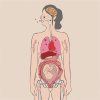Human Coronavirus Infections and Pregnancy
- PMID: 34192279
- PMCID: PMC7834663
- DOI: 10.1097/FM9.0000000000000071
Human Coronavirus Infections and Pregnancy
Abstract
Human coronavirus (HCoV) causes potentially fatal respiratory disease. Pregnancy is a physiological state that predisposes women to viral infection. In this review, we aim to present advances in the pathogenesis, clinical features, diagnosis, and treatment in HCoV in pregnancy. We retrieved information from the Pubmed database up to June 2020, using various search terms and relevant words, including coronaviruses, severe acute respiratory syndrome coronavirus, Middle East respiratory syndrome coronavirus, 2019 coronavirus disease, and pregnancy. Both basic and clinical studies were selected. We found no evidence that pregnant women are more susceptible to HCoV infection or that those with HCoV infection are more prone to developing severe pneumonia. There is also no confirmed evidence of vertical mother-to-child transmission of HcoV infection during maternal HCoV infection. Those diagnosed with infection should be promptly admitted to a negative-pressure isolation ward, preferably in a designated hospital with adequate facilities and multi-disciplinary expertise to manage critically ill obstetric patients. Antiviral treatment has been routinely used to treat pregnant women with HCoV infection. The timing and mode of delivery should be individualized, depending mainly on the clinical status of the patient, gestational age, and fetal condition. Early cord clamping and temporary separation of the newborn for at least 2 weeks is recommended. All medical staff caring for patients with HCoV infection should use personal protective equipment. This review highlights the advances in pathogenesis, maternal-fetal outcome, maternal-fetal transmission, diagnosis and treatment in HCoV including severe acute respiratory syndrome coronavirus, Middle East respiratory syndrome coronavirus, and coronavirus disease 2019 in pregnancy.
Keywords: COVID-19; Coronavirus; MERS-CoV; Pregnancy; SARS-CoV; SARS-CoV-2.
Copyright © 2021 The Chinese Medical Association, published by Wolters Kluwer Health, Inc.
Conflict of interest statement
None.
Figures




Similar articles
-
The effect of coronavirus infection (SARS-CoV-2, MERS-CoV, and SARS-CoV) during pregnancy and the possibility of vertical maternal-fetal transmission: a systematic review and meta-analysis.Eur J Med Res. 2020 Sep 4;25(1):39. doi: 10.1186/s40001-020-00439-w. Eur J Med Res. 2020. PMID: 32887660 Free PMC article.
-
Outcome of coronavirus spectrum infections (SARS, MERS, COVID-19) during pregnancy: a systematic review and meta-analysis.Am J Obstet Gynecol MFM. 2020 May;2(2):100107. doi: 10.1016/j.ajogmf.2020.100107. Epub 2020 Mar 25. Am J Obstet Gynecol MFM. 2020. PMID: 32292902 Free PMC article.
-
Coronavirus Disease 2019 (COVID-19) and pregnancy: what obstetricians need to know.Am J Obstet Gynecol. 2020 May;222(5):415-426. doi: 10.1016/j.ajog.2020.02.017. Epub 2020 Feb 24. Am J Obstet Gynecol. 2020. PMID: 32105680 Free PMC article. Review.
-
In vitro virucidal activity of Echinaforce®, an Echinacea purpurea preparation, against coronaviruses, including common cold coronavirus 229E and SARS-CoV-2.Virol J. 2020 Sep 9;17(1):136. doi: 10.1186/s12985-020-01401-2. Virol J. 2020. PMID: 32907596 Free PMC article.
-
Care of the pregnant woman with coronavirus disease 2019 in labor and delivery: anesthesia, emergency cesarean delivery, differential diagnosis in the acutely ill parturient, care of the newborn, and protection of the healthcare personnel.Am J Obstet Gynecol. 2020 Jul;223(1):66-74.e3. doi: 10.1016/j.ajog.2020.04.005. Epub 2020 Apr 10. Am J Obstet Gynecol. 2020. PMID: 32283073 Free PMC article.
Cited by
-
Maternal and Perinatal Outcomes of SARS-CoV-2 and Variants in Pregnancy.Matern Fetal Med. 2023 Mar 27;5(2):104-114. doi: 10.1097/FM9.0000000000000189. eCollection 2023 Apr. Matern Fetal Med. 2023. PMID: 40406388 Free PMC article.
-
COVID-19 Infection Complicated by Disseminated Intravascular Coagulation during Pregnancy-Two Cases Report.Diagnostics (Basel). 2022 Mar 8;12(3):655. doi: 10.3390/diagnostics12030655. Diagnostics (Basel). 2022. PMID: 35328208 Free PMC article.
-
Pregnancy and Severe ARDS with COVID-19: Epidemiology, Diagnosis, Outcomes and Treatment.Semin Fetal Neonatal Med. 2023 Feb;28(1):101426. doi: 10.1016/j.siny.2023.101426. Epub 2023 Mar 7. Semin Fetal Neonatal Med. 2023. PMID: 36964118 Free PMC article. Review.
-
First Neonates with Vertical Transmission of SARS-CoV-2 Infection in Late Pregnancy in West Part of Romania: Case Series.Diagnostics (Basel). 2022 Jul 9;12(7):1668. doi: 10.3390/diagnostics12071668. Diagnostics (Basel). 2022. PMID: 35885572 Free PMC article.
-
Severe Acute Respiratory Syndrome Coronavirus 2 Infection in Pregnancy. A Non-systematic Review of Clinical Presentation, Potential Effects of Physiological Adaptations in Pregnancy, and Placental Vascular Alterations.Front Physiol. 2022 Mar 30;13:785274. doi: 10.3389/fphys.2022.785274. eCollection 2022. Front Physiol. 2022. PMID: 35431989 Free PMC article. Review.
References
-
- Drosten C, Günther S, Preiser W, et al. Identification of a novel coronavirus in patients with severe acute respiratory syndrome. N Engl J Med 2003;348(20):1967–1976. doi:10.1056/NEJMoa030747. - PubMed
Publication types
LinkOut - more resources
Full Text Sources
Miscellaneous
